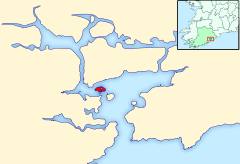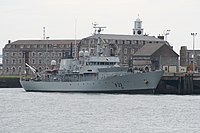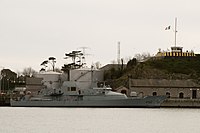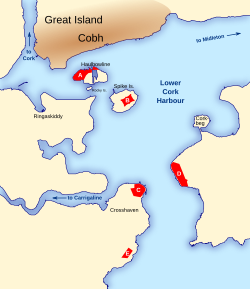Haulbowline
| Haulbowline Island Irish: Inis Sionnach | |
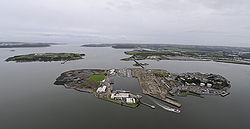 Aerial view of the island | |
|---|---|
| Location | |
| Location: | 51°50’30"N, 8°18’0"W |
| Grid reference: | W794655 |
| Area: | 86 acres |
| Data | |
Haulbowline is an island in Cork Harbour on the south coast of County Cork. The world's first yacht club, the Royal Cork Yacht Club, was founded on Haulbowline in 1720.[1]
The island has a major, long bite out of the middle of it: the deep-water dock built for the Royal Navy.
The western side of the island is the main naval base and headquarters for the Irish Naval Service, with the eastern side previously used for heavy industry and later redeveloped as a park.[2] Since 1966 the island has been connected to the mainland by a roadbridge.[3]
Name
The island's name in its current form appears to be a humorous adaptation by sailors of the Royal Navy, men familiar with hauling bowlines. In origin it is from the Old Norse language, possibly from ál-boling or similar, which would mean 'eel dwelling'. The 17th and 18th-century spellings end in "-ing". The Irish language name for the island, Inis Sionnach, translates to "island of the foxes".
At a strategic and deepwater position in the harbour, the island has long been of naval importance. The island was first fortified in 1602, and initially an important base for the British Army. In 1603 the Cork city fathers were accused of attempting to demolish it, and William Meade, the Recorder of Cork, was charged with treason as a result.
In 1720, much of the island was owned by the Cork Water Club, later connected to the Royal Cork Yacht Club (claimed as the world's first yacht club).[1] There was a castle on the island which was the clubhouse for the Cork Water Club.[4]
In 1806, the British Army moved to nearby Spike Island, and the fortifications were handed over, with 14 acres of land going to the Royal Navy, and the remaining eight acres to the Board of Ordnance.[5] (At the time the island was less than half its present size.)
An Ordnance Yard was established on the westernmost part of the island, separated from the rest by a large stone wall. A Martello tower was built for defence, and in 1808 a pair of magazines were erected on nearby Rocky Island with capacity for 25,000 barrels of gunpowder. East of the wall a Victualling Yard was laid out, and from 1807–1824 a series of buildings were constructed, several of which are still standing. Most prominent are six large storehouses, three grouped together around a quay on the north side of the island, and three along what was then its eastern edge. Behind these was a large rectangular rainwater tank (which collected fresh water for the ships), on top of which was a quadrangular cooperage complex. To the south were a mast and boat store, at the top of a slipway, and to the west, along the length of the wall, were cottages and houses for the workers and officers of the yard.[5] At this time, some four acres were added to the island through land reclamation, the first of several such additions.
Quite soon after so much investment, the Navy announced the closure of the Yard in 1831; ten years later, though, it reopened.[5] The next major development came in the 1860s with the establishment of a Royal Navy Dockyard on Haulbowline, for warship repair and construction. To accommodate this new industrial complex the island was doubled in size to a total of around 60 acres. The large basin was constructed, which today bisects the island, with a 408-foot dry dock at one end (extended to 600 feet just before the First World War). By the 20th century, the (now renamed) Royal Alexandra Victualling Yard area also contained a coaling/fuelling depot, as well as a naval hospital (housed in one of the Storehouses).[5]
In June 1940, an Irish Marine and Coastwatching Service Motor Torpedo Boat (MTB) returned to Haulbowline after making two trips to rescue French and British soldiers during the Dunkirk evacuation.[6]
Unlike the other fortifications in Cork Harbour, which formed part of the treaty port retained by Britain, the dockyard was handed over to the Irish Free State in 1923, and remains the main naval base and headquarters for the Irish Naval Service. The majority of the Naval Service campus is on the west of the Island - much of it within the former Ordnance Yard – save for the service's football pitch which was reclaimed from land on the eastern side in the 1980s.[7] In September 2014, the Minister for Defence Simon Coveney announced plans for a €50m upgrade of the naval base with improved quays to cater for the Naval Service's new ships and the construction of a runway to enable the Naval Service to operate UAV drones.[8]
In March 2008, one of the historic 19th century industrial storehouses on Haulbowline Island was destroyed by fire, leaving only its walls still standing.[9]
Industry and development
Irish Steel (later known as Irish Ispat) was based on the east of the island, on the site formerly occupied by the 1869 Dockyard, between 1939 and 2001. In July 2006, it was announced that the former steel plant site would be developed with apartments, offices, a hotel and a marina.[10] However, this plan was shelved when the 'Celtic tiger' period came to an end in 2008.[11]
References
- ↑ 1.0 1.1 "National Inventory of Architectural Heritage – Haulbowline Island, East Cork". Buildingsofireland.ie. http://www.buildingsofireland.ie/niah/search.jsp?type=record&county=EC®no=20908767.
- ↑ "Haulbowline Island park set finally to open to the public". Irish Examiner. 14 January 2021. https://www.irishexaminer.com/news/munster/arid-40207271.html. Retrieved 3 June 2021.
- ↑ "The Island Crematorium - History". Islandcrematorium.ie. http://www.islandcrematorium.ie/history/.
- ↑ Corinthian, History of yachting in the South of Ireland, 1720–1908 (Cork, 1909)
- ↑ 5.0 5.1 5.2 5.3 Coad, Jonathan (2013). Support for the Fleet: Architecture and engineering of the Royal Navy's bases, 1700-1914. Swindon: English Heritage.
- ↑ "Price of Fighting in the Second World War". Irish Times. 6 November 2010. https://www.irishtimes.com/news/price-of-fighting-in-the-second-world-war-1.673514. "The [motor torpedo boat] crew made two trips across the English Channel, rescuing French and British soldiers"
- ↑ "Toxic Island: The Story of Haulbowline Island". FriendsoftheIrishEnvironment.net. http://www.friendsoftheirishenvironment.net/cmsfiles/files/library/toxic_island.pdf.
- ↑ "Navy to Use Drones to Improve Surveillance". Irish Examiner. http://www.irishexaminer.com/ireland/navy-to-use-drones-to-improve-surveillance-285010.html.
- ↑ "RTÉ News Report on Storehouse Fire". RTÉ.ie. 12 March 2008. http://www.rte.ie/news/2008/0312/cork.html.
- ↑ "2006 Press Release from the Department of Jobs, Enterprise and Innovation – Major new redevelopment planned for Haulbowline". Djei.ie. 30 September 2013. http://www.djei.ie/press/2006/20060728.htm.
- ↑ "Oireachtas Hansard – Written Answers - Remediation of Industrial Sites (Questions relating to OPW working group to manage and develop Haulbowline)". Debate record. Houses of the Oireachtas. 17 June 2010. https://www.oireachtas.ie/en/debates/debate/dail/2010-06-17/31/?highlight%5B0%5D=haulbowline&highlight%5B1%5D=haulbowline#s65.
